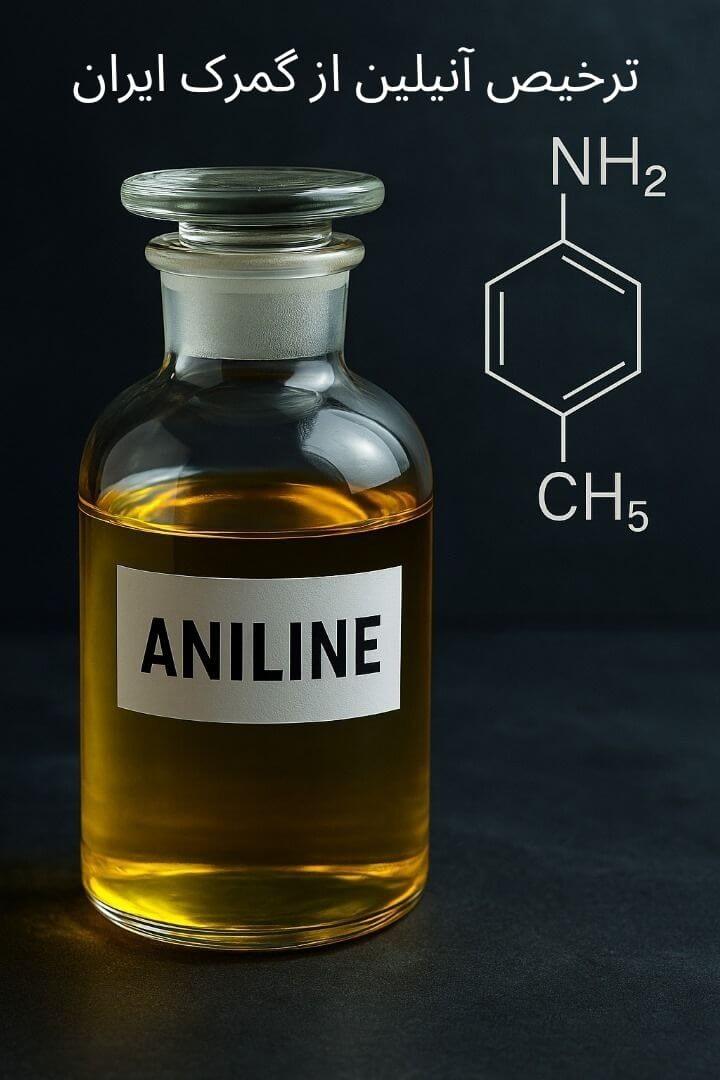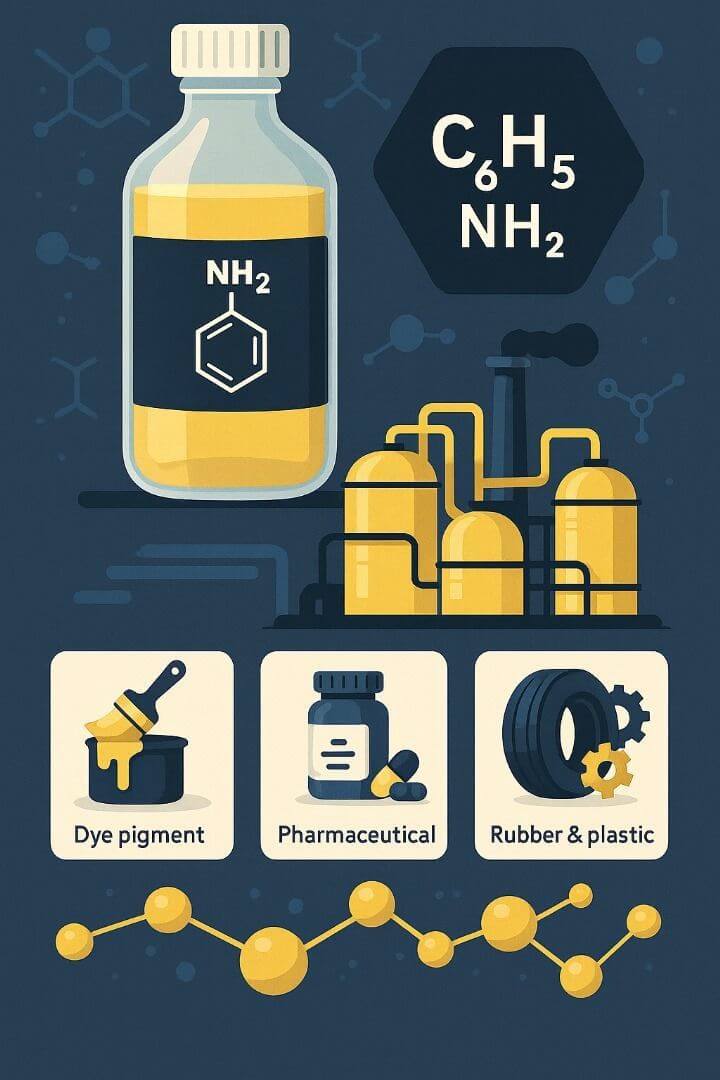Customs Clearance of Aniline in Iran (HS Code + Documents & Permits)

For estimating timeline and costs of aniline customs clearance, contact the Saba Tarkhis experts.
Instant Free Consultation1) Detailed Product Description: Features & Importance of Aniline
- Nature: Aromatic organic liquid, clear to pale yellow, with a sharp, penetrating odor.
- Chemical name: Phenylamine (Aniline) | Formula: C6H5NH2.
- Key applications (preserving your content): production of organic dyes in textiles, pharmaceutical intermediate, rubber and plastics industry, production of polyurethane and other industrial polymers.
- Commercial importance: a vital material in the chemical supply chain with steady demand in domestic and global markets.
2) Types & Applications
- Organic dye manufacturing: one of the primary uses of aniline is in producing organic dyes used in dyeing and textile industries.
Pharmaceutical industry: aniline serves as a starting material for manufacturing various drugs and pharmaceutical compounds.
Rubber & plastics industries: an essential precursor in synthetic rubber and plastics production.
Given its broad applications, aniline has become a critical substance in the chemical industry, and its import and export are highly significant worldwide.
3) Key Considerations for Aniline Customs Clearance
- Due to its hazardous chemical properties, aniline is subject to special controls. As a hazardous chemical, its import requires strict compliance with safety and health requirements, including:
Required permits from competent authorities: aniline requires special permits from environmental and health organizations. Violations can result in heavy fines or even import bans.
Safety & transport standards: because of its chemical hazards, aniline must follow international standards for transport and storage. Shipment must be supervised and handled under specific protocols to prevent environmental contamination and other risks.
Environmental controls: import must align with the environmental standards of the importing country. To mitigate environmental risks, certificates of analysis must be provided to customs so the chemical specifications can be verified.
4) Customs Tariff / HS Code
The customs tariff code or HS Code for aniline is typically 2921.41.00. This code is specific to aniline and must be used correctly throughout all import stages—from order registration to final clearance. Correct HS classification speeds up customs procedures and helps minimize legal issues. Checking up-to-date tariff schedules—subject to changes from trade agreements or national trade policies—is essential.
| Goods | Short Description | HS Code |
|---|---|---|
| Aniline (Phenylamine) | Aromatic organic compound; feedstock for dyes/pharma/polymers | 2921.41.00 (29214100) |
Exact classification depends on form, purity, additives, and end-use.
5) Special Conditions for Import & Export of Aniline
- Given its hazardous nature, aniline is under special controls. As a hazardous chemical, its import requires strict compliance with safety and health requirements, including:
Permits from competent authorities: special permits from environmental and health bodies are required. Non-compliance can lead to heavy penalties or import prohibitions.
Safety & transport standards: international standards for transport and warehousing must be observed, with supervised handling to prevent environmental contamination and potential hazards.
Environmental controls: imports must conform to national environmental standards. Certificates of analysis should be submitted to customs to verify chemical specifications.
6) Iran Market: Import Origins & Export Status
As for exports, Iran has not yet recorded significant outbound shipments of aniline. The country’s focus is largely on meeting domestic demand through imports.
7) Trade Volumes: Iran & Global Turnover
Globally, the trade turnover of aniline is estimated at about 2 million tons per year. Owing to its broad industrial applications—especially in dyes and chemicals—aniline is a key commodity in international markets. Demand is rising, and exporting countries command a considerable share of this market.
8) Global Market: Major Exporters & Importers
China: recognized as the world’s largest producer and exporter of aniline, with high production capacity and access to raw materials.
Germany: another leading exporter; with advanced industrial infrastructure, it ships substantial volumes worldwide.
United States: with its developed chemical and petrochemical sectors, the U.S. is also a major aniline exporter.
Major global importers of aniline:
India: one of the largest importers, using aniline across sectors—especially pharmaceuticals and dye manufacturing.
Brazil: another major importer, utilizing aniline in petrochemical and chemical industries.
Iran: due to strong industrial demand, Iran is a significant importer, sourcing mainly from China and India.
9) Required Documents for Aniline Customs Clearance
Proforma invoice:
A commercial document detailing the price and specifications of the goods. It must include seller and buyer names and addresses, issue date, and aniline details (type, quantity, and packaging). Accurate preparation helps prevent disputes during clearance.
Packing list:
Describes shipment details: number of packages, net and gross weights, dimensions of each package, and packaging type (e.g., carton or drum). These details are crucial for proper control and assessment at customs and affect clearance speed.
Certificate of origin:
Confirms the country where aniline was produced. It is essential for identifying origin and for setting applicable duties. It must include producer details, issue date, and authorized signatures.
Certificate of Analysis (CoA):
Shows quality and chemical specifications. Typically includes test results for purity percentage and impurities. Must be issued by a reputable laboratory and is particularly important for customs.
Import permits:
Due to the hazardous nature of aniline, special permits from competent authorities and compliance with safety and health requirements are necessary. These should be obtained before import and include approvals from health, environmental, and chemical industry agencies.
Customs inspection report:
Confirms the consignment has been fully and correctly inspected by customs officials. It states inspection outcomes and confirms legal and safety status, helping to facilitate clearance.
Transport document:
Covers shipment details and should include the bill of lading, container number, carrier information, and dispatch date—useful for tracking routing and final delivery.
Product datasheet/ID:
Provides technical and identification information for aniline, including chemical composition and properties—essential for personnel and organizations handling the substance.
Key Tips & Practical Recommendations
- Prepare a valid CoA and an up-to-date SDS from the outset to speed inspections.
- Pre-submit documents and request pre-review in the system to reduce dwell time.
- Use appropriate containers and correct labeling in line with dangerous goods transport standards.
- If tariffs or regulations change, update your order registration accordingly.

Frequently Asked Questions
What is the HS Code for aniline?
The common code for aniline is 2921.41.00 (29214100), which must be used correctly throughout all import steps.
What documents are required to clear aniline?
Proforma, packing list, bill of lading, certificate of origin, CoA, health/environmental permits, customs inspection report, and transport documents.
Are special permits required to import aniline?
Yes. Owing to its hazardous nature, permits from health and environmental authorities are mandatory before import.
How can we reduce aniline clearance time?
Pre-submit documents, coordinate with customs for pre-review, prepare a complete CoA, and choose a customs facility equipped for hazardous chemicals.
Specialized Customs-Clearance Services by Saba Brokerage
Leveraging extensive experience and expertise in customs clearance, we provide comprehensive services for our clients, including the following:Specialized consulting: accurate, expert guidance on the best clearance methods, plus up-to-date information on customs rules and regulations. Our experts analyze your specific needs to define the best strategy to streamline clearance.
Document preparation: assistance in compiling all documents required for clearance—proforma, certificate of origin, certificate of analysis, and other paperwork—along with validation to prevent issues during customs stages.
Engagement with customs authorities: effective, continuous communication with customs officials to facilitate clearance and resolve administrative hurdles—especially important for complex cases requiring special permits—and to accelerate the process.
Risk management: identification and mitigation of potential risks related to clearance, particularly for hazardous chemicals like aniline. Includes market condition assessments, legal-risk identification, and practical mitigation proposals.
Post-clearance services: tracking shipment status and ensuring accurate and timely delivery to the customer, including oversight of handoff stages and resolution of possible issues so customers stay informed at every step.
Market analytics: detailed analytical reports on market conditions, price movements, and trade trends to optimize import decisions—helping you select the best timing and terms for import.
Tailored to your specific needs, we deliver the best solutions to simplify and speed up customs clearance. With these services, you’ll benefit from our team’s expertise and manage the clearance of aniline and other chemicals with greater confidence.
.png)
